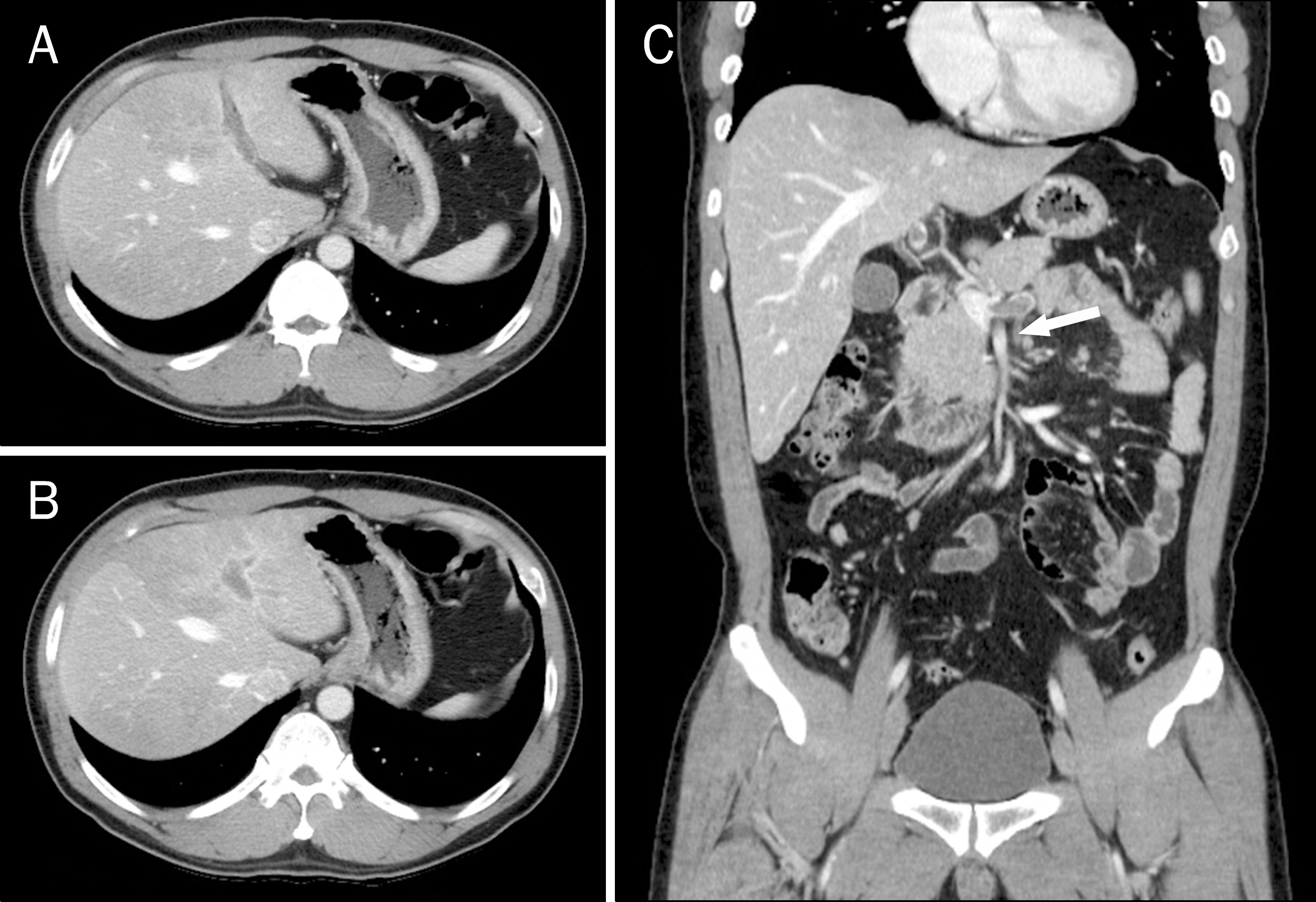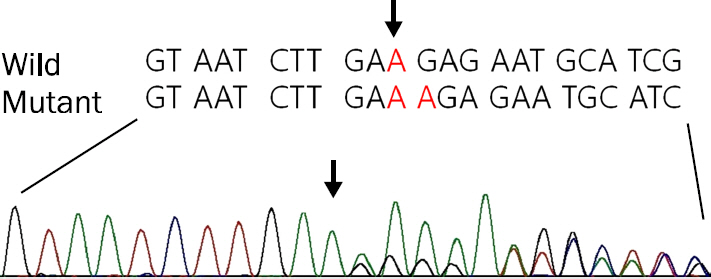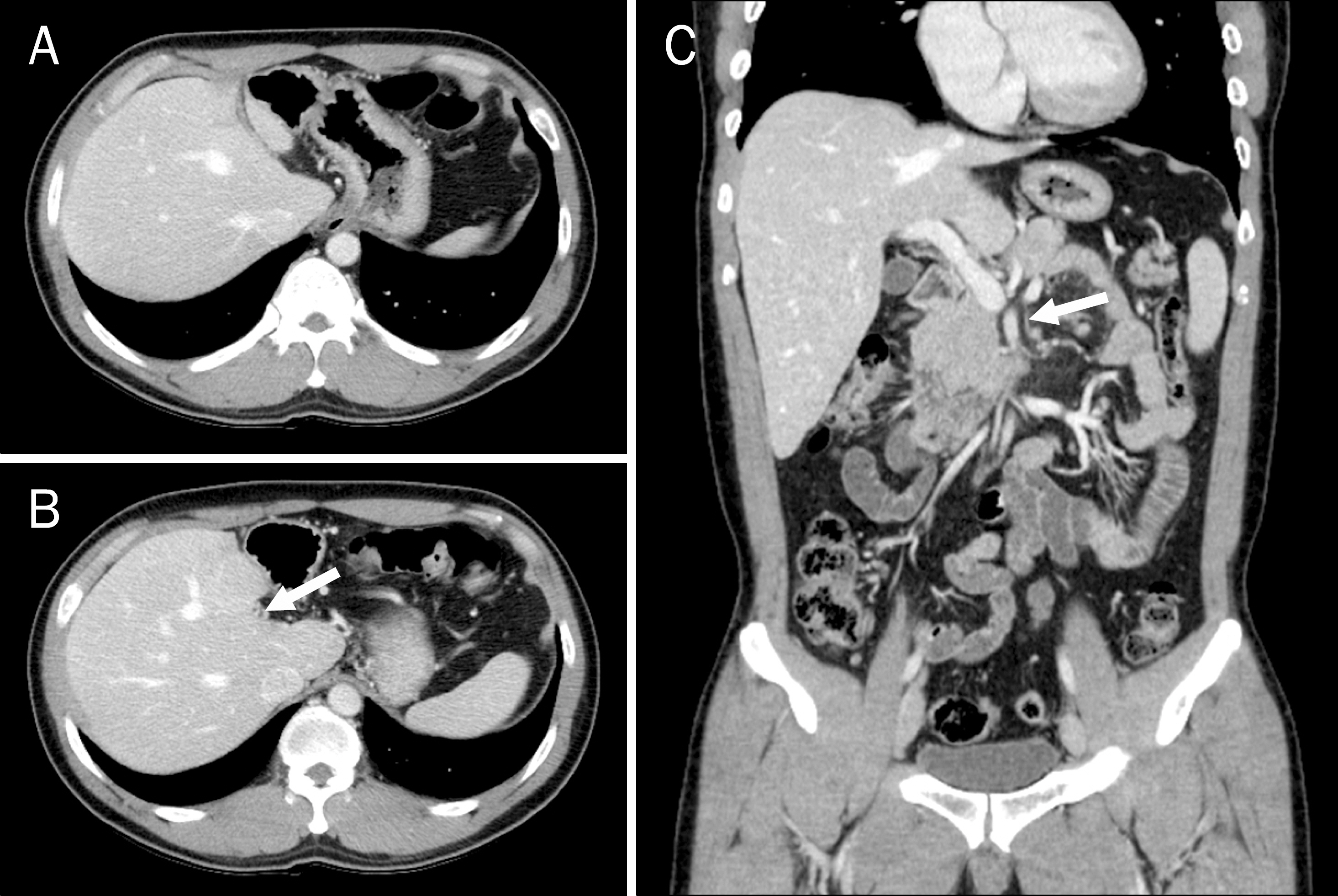Korean J Gastroenterol.
2014 Aug;64(2):110-114. 10.4166/kjg.2014.64.2.110.
Portal-Splenic-Mesenteric Venous Thrombosis in a Patients with Protein S Deficiency due to Novel PROS1 Gene Mutation
- Affiliations
-
- 1Division of Gastroenterology, Department of Internal Medicine, Myongji Hospital, Goyang, Korea. cjs0123@hanmail.net
- 2Department of Laboratory Medicine and Genetics, Samsung Medical Center, Sungkyunkwan University School of Medicine, Seoul, Korea.
- KMID: 2164422
- DOI: http://doi.org/10.4166/kjg.2014.64.2.110
Abstract
- Protein S (PS), a vitamin K-dependent glycoprotein, performs an important role in the anticoagulation cascade as a cofactor of protein C. Because of the presence of a pseudogene and two different forms of PS in the plasma, protein S deficiency (PSD) is one of the most difficult thrombophilias to study and a rare blood disorder associated with an increased risk of thrombosis. We describe a unusual case of previously healthy 37-year-old man diagnosed with portal-splenic-mesenteric vein thrombosis secondary to PSD. The patient was admitted to the hospital due to continuous nonspecific abdominal pain and nausea. Abdominal computed tomography revealed acute venous thrombosis from inferior mesenteric vein to left portal vein via splenic vein, and laboratory test revealed decreased PS antigen level and PS functional activity. Conventional polymerase chain reaction and direct DNA sequencing analysis of the PROS1 gene demonstrated duplication of the 166th base in exon 2 resulting in frame-shift mutation (p.Arg56Lysfs*10) which is the first description of the new PROS1 gene mutation to our knowledge. Results from other studies suggest that the inherited PSD due to a PROS1 gene mutation may cause venous thrombosis in a healthy young man without any known predisposing factor.
MeSH Terms
-
Adult
Anticoagulants/therapeutic use
Base Sequence
Blood Proteins/*genetics
Codon, Terminator
Exons
Humans
Male
Mesenteric Veins/radiography
Polymorphism, Restriction Fragment Length
Portal Vein/radiography
Protein S Deficiency/complications/*diagnosis
Sequence Analysis, DNA
Splenic Vein/radiography
Tomography, X-Ray Computed
Venous Thrombosis/*diagnosis/drug therapy/etiology
Anticoagulants
Blood Proteins
Codon, Terminator
Figure
Reference
-
References
1. DiScipio RG, Davie EW. Characterization of protein S, a gamma-carboxyglutamic acid containing protein from bovine and human plasma. Biochemistry. 1979; 18:899–904.
Article2. Schwarz HP, Fischer M, Hopmeier P, Batard MA, Griffin JH. Plasma protein S deficiency in familial thrombotic disease. Blood. 1984; 64:1297–1300.
Article3. Seligsohn U, Lubetsky A. Genetic susceptibility to venous thrombosis. N Engl J Med. 2001; 344:1222–1231.
Article4. Ji M, Yoon SN, Lee W, et al. Protein S deficiency with a PROS1 gene mutation in a patient presenting with mesenteric venous thrombosis following total colectomy. Blood Coagul Fibrinolysis. 2011; 22:619–621.
Article5. ten Kate MK, van der Meer J. Protein S deficiency: a clinical perspective. Haemophilia. 2008; 14:1222–1228.
Article6. Singal AK, Kamath PS, Tefferi A. Mesenteric venous thrombosis. Mayo Clin Proc. 2013; 88:285–294.
Article7. Ponziani FR, Zocco MA, Campanale C, et al. Portal vein thrombosis: insight into physiopathology, diagnosis, and treatment. World J Gastroenterol. 2010; 16:143–155.
Article8. Parker C, Omine M, Richards S, et al. International PNH Interest Group. Diagnosis and management of paroxysmal nocturnal hemoglobinuria. Blood. 2005; 106:3699–3709.
Article9. De Stefano V, Fiorini A, Rossi E, et al. Incidence of the JAK2 V617F mutation among patients with splanchnic or cerebral venous thrombosis and without overt chronic myeloproliferative disorders. J Thromb Haemost. 2007; 5:708–714.
Article10. García de Frutos P, Fuentes-Prior P, Hurtado B, Sala N. Molecular basis of protein S deficiency. Thromb Haemost. 2007; 98:543–556.
Article11. Duebgen S, Kauke T, Marschall C, et al. Genotype and laboratory and clinical phenotypes of protein s deficiency. Am J Clin Pathol. 2012; 137:178–184.
Article12. Johansson AM, Hillarp A, Säll T, Zöller B, Dahlbäck B, Halldén C. Large deletions of the PROS1 gene in a large fraction of mutation-negative patients with protein S deficiency. Thromb Haemost. 2005; 94:951–957.
Article13. Holmes ZR, Bertina RM, Reitsma PH. Characterization of a large chromosomal deletion in the PROS1 gene of a patient with protein S deficiency type I using long PCR. Br J Haematol. 1996; 92:986–991.
Article14. Choung HS, Kim HJ, Gwak GY, Kim SH, Kim DK. Inherited protein S deficiency as a result of a large duplication mutation of the PROS1 gene detected by multiplex ligation-dependent probe amplification. J Thromb Haemost. 2008; 6:1430–1432.15. Yoo JH, Kim HJ, Maeng HY, et al. Hereditary protein S deficiency from a novel large deletion mutation of the PROS1 gene detected by multiplex ligation-dependent probe amplification (MLPA). Thromb Res. 2009; 123:793–795.
Article16. Hertzberg MS. Genetic testing for thrombophilia mutations. Semin Thromb Hemost. 2005; 31:33–38.
Article17. Riva N, Donadini MP, Dentali F, Squizzato A, Ageno W. Clinical approach to splanchnic vein thrombosis: risk factors and treatment. Thromb Res. 2012; 130(Suppl 1):S1–S3.
Article
- Full Text Links
- Actions
-
Cited
- CITED
-
- Close
- Share
- Similar articles
-
- Pulmonary Thromboembolism Caused by PROS1 Gene Mutation
- Inherited protein S deficiency due to a novel nonsense mutation in the PROS1 gene in the patient with recurrent vascular access thrombosis: A case report
- A Case of Superior Mesenteric Venous Thrombosis Due to Protein C Deficiency in a Patient with Duodenal Ulcer Bleeding
- Mesenteric Venous Thrombosis due to Protein S Deficiency
- Unusual Complication of Crohn's Disease: Portal Hypertension Related with Rapid Progression of Portal Vein and Superior Mesenteric Vein Thrombosis




